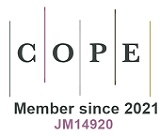The Prevalence of blaNDM-1 in Clinical Isolates of Carbapenem-resistant Pseudomonas Aeruginosa: A Systematic Review
Downloads
Doi: 10.28991/SciMedJ-2021-0304-9
Full Text: PDF
Downloads
Ruiz-Garbajosa, P., & Cantón, R. (2017). Epidemiology of antibiotic resistance in Pseudomonas aeruginosa. Implications for empiric and definitive therapy. Revista espanola de quimioterapia: publicacion oficial de la Sociedad Espanola de Quimioterapia, 30 Suppl 1, 8–12.
Mayers, D. L., Sobel, J. D., Ouellette, M., Kaye, K.S. (2017). Antimicrobial Drug Resistance. Mechanism of Drug Resistance. In Springer International Publishing. doi:10.1007/978-3-642-10324-7_10.
Pachori, P., Gothalwal, R., & Gandhi, P. (2019). Emergence of antibiotic resistance Pseudomonas aeruginosa in intensive care unit; a critical review. Genes & Diseases, 6(2), 109–119. doi:10.1016/j.gendis.2019.04.001.
Pseudomonas aeruginosa Infection. (2020). Availble online: https://www.cdc.gov/hai/organisms/pseudomonas.html. (accessed on May 2021).
Gales, A. C., Menezes, L. C., Silbert, S., & Sader, H. S. (2003). Dissemination in distinct Brazilian regions of an epidemic carbapenem-resistant Pseudomonas aeruginosa producing SPM metallo-beta-lactamase. The Journal of antimicrobial chemotherapy, 52(4), 699–702. doi:10.1093/jac/dkg416.
Shashikala, Devi, S., Kanungo, R., & Srinivasan, S. (2006). Emerging resistance to carbapenems in hospital acquiredPseudomonasinfection: A cause for concern. Indian Journal of Pharmacology, 38(4), 287. doi:10.4103/0253-7613.27029.
Meletis, G., Exindari, M., Vavatsi, N., Sofianou, D., & Diza, E. (2012). Mechanisms responsible for the emergence of carbapenem resistance in Pseudomonas aeruginosa. Hippokratia, 16(4), 303–307.
Tesalona, S., Lagamayo, E., Evangelista, I. N., Ormita, M. J., & Pacia, C. J. (2017). Emergence of Bla oxa-23 and Bla ndm-1 in Carbapenem-Resistant Pseudomonas aeruginosa and Acinetobacter baumannii in Selected Tertiary Hospitals in Metro Manila. Philippines. JSM Microbiology, 5(2): 1043.
Meletis G. (2016). Carbapenem resistance: overview of the problem and future perspectives. Therapeutic advances in infectious disease, 3(1), 15–21. doi:10.1177/2049936115621709.
Palzkill, T. (2012). Metallo-β-lactamase structure and function. Annals of the New York Academy of Sciences, 1277(1), 91–104. doi:10.1111/j.1749-6632.2012.06796.x.
Lauretti, L., Riccio, M. L., Mazzariol, A., Cornaglia, G., Amicosante, G., Fontana, R., & Rossolini, G. M. (1999). Cloning and characterization of bla(VIM), a new integron-borne metallo- β-lactamase gene from a Pseudomonas aeruginosa clinical isolate. Antimicrobial Agents and Chemotherapy. 43(7), 1584–1590. doi:10.1128/aac.43.7.1584.
Yong, D., Toleman, M. A., Giske, C. G., Cho, H. S., Sundman, K., Lee, K., & Walsh, T. R. (2009). Characterization of a new metallo-β-lactamase gene, bla NDM-1, and a novel erythromycin esterase gene carried on a unique genetic structure in Klebsiella pneumoniae sequence type 14 from India. Antimicrobial Agents and Chemotherapy. 53(12), 5046–5054. doi:10.1128/AAC.00774-09.
Shanthi, M., Sekar, U., Kamalanathan, A., & Sekar, B. (2014). Detection of New Delhi metallo beta lactamase-1 (NDM-1) carbapenemase in Pseudomonas aeruginosa in a single centre in southern India. The Indian journal of medical research, 140(4), 546–550.
Lautenbach, E., Synnestvedt, M., Weiner, M. G., Bilker, W. B., Vo, L., Schein, J., & Kim, M. (2010). Imipenem Resistance in Pseudomonas aeruginosa Emergence, Epidemiology, and Impact on Clinical and Economic Outcomes. Infection Control & Hospital Epidemiology, 31(1), 47–53. doi:10.1086/649021.
Moher, D., Liberati, A., Tetzlaff, J., & Altman, D. G. (2009). Preferred Reporting Items for Systematic Reviews and Meta-Analyses: The PRISMA Statement. PLoS Medicine, 6(7), e1000097. doi:10.1371/journal.pmed.1000097.
Joanna Briggs Institute. (2020). JBI critical appraisal checklist for prevalence studies.
Joanna Briggs Institute. (2017). JBI critical appraisal checklist for case reports.
Paul, D., Garg, A., & Bhattacharjee, A. (2017). Occurrence of blaNDM-1 and blaNDM-5 in a Tertiary Referral Hospital of North India. Microbial drug resistance (Larchmont, N.Y.), 23(7), 815–821. doi:10.1089/mdr.2016.0124.
Hussein, Z. K., Kadhim, H. S., & Hassan, J. S. (2018). Detection of New Delhi metallo-beta-lactamase-1 (blaNDM-1) in carbapenem-resistant pseudomonas aeruginosa isolated from clinical samples in Wasit hospitals. Iraqi JMS. 2018; 16 (3): 239-246. doi:10.22578/IJMS.16.3.3.
Alsaadi, L. A. S., Al-Dulaimi, A. A. F., & Al-Taai, H. R. R. (2020). Prevalence of blaVIM, blaIMP and blaNDM Genes in Carbapenem Resistant Pseudomonas Aeruginosa Isolated from Different Clinical Infections in Diyala, Iraq. Indian Journal of Public Health Research & Development, 11(2), 2264. doi:10.37506/v11/i2/2020/ijphrd/195173.
Mathur, P., Bajpai, V., Govindaswamy, A., Khurana, S., Batra, P., Aravinda, A., … Malhotra, R. (2019). Phenotypic & genotypic profile of antimicrobial resistance in Pseudomonas species in hospitalized patients. Indian Journal of Medical Research, 149(2), 216. doi:10.4103/ijmr.ijmr_1_18.
Joji, R. M., Al-Rashed, N., Saeed, N. K., & Bindayna, K. M. (2019). Detection of VIM and NDM-1 metallo-beta-lactamase genes in carbapenem-resistant Pseudomonas aeruginosa clinical strains in Bahrain. Journal of laboratory physicians, 11(2), 138–143. doi:10.4103/JLP.JLP_118_1.
Wang, W., & Wang, X. (2020). Prevalence of metallo-β-lactamase genes among Pseudomonas aeruginosa isolated from various clinical samples in China. Journal of Laboratory Medicine, 44(4), 197–203. doi:10.1515/labmed-2019-0162.
Baban, S. T. (2020). Molecular detection of carbapenemase-producing Pseudomonas aeruginosa isolated from intensive care units of surgical specialty hospital in Erbil city. Medical Journal of Babylon, 17(2), 185. doi:10.4103/MJBL.MJBL_24_20.
Farajzadeh Sheikh, A., Shahin, M., Shokoohizadeh, L., Ghanbari, F., Solgi, H., & Shahcheraghi, F. (2020). Emerge of NDM-1-producing multidrug-resistant pseudomonas aeruginosa and co-harboring of carbapenemase genes in South of Iran. Iranian Journal of Public Health. doi:10.18502/ijph.v49i5.3214.
Walters, M., Grass, J. E., Bulens, S. N., Hancock, E. B., Phipps, E. C., Muleta, D....Kallen, A. (2019). Carbapenem-Resistant Pseudomonas aeruginosa at US Emerging Infections Program Sites, 2015. Emerging Infectious Diseases, 25(7), 1281-1288. doi:10.3201/eid2507.181200.
Farajzadeh Sheikh, A., Shahin, M., Shokoohizadeh, L., Ghanbari, F., Solgi, H., & Shahcheraghi, F. (2020). Emerge of NDM-1-Producing Multidrug-Resistant Pseudomonas aeruginosa and Co-harboring of Carbapenemase Genes in South of Iran. Iranian Journal of Public Health. doi:10.18502/ijph.v49i5.3214.
Jovcic, B., Lepsanovic, Z., Suljagic, V., Rackov, G., Begovic, J., Topisirovic, L., & Kojic, M. (2011). Emergence of NDM-1 Metallo-β-Lactamase inPseudomonas aeruginosaClinical Isolates from Serbia. Antimicrobial Agents and Chemotherapy, 55(8), 3929–3931. doi:10.1128/aac.00226-11.
Khajuria, A., Praharaj, A. K., Kumar, M., & Grover, N. (2013). Emergence of NDM - 1 in the Clinical Isolates of Pseudomonas aeruginosa in India. Journal of clinical and diagnostic research: JCDR, 7(7), 1328–1331. doi:10.7860/JCDR/2013/5509.3137.
Paul, D., Dhar, D., Maurya, A. P., Mishra, S., Sharma, G. D., Chakravarty, A., & Bhattacharjee, A. (2016). Occurrence of co-existing bla VIM-2 and bla NDM-1 in clinical isolates of Pseudomonas aeruginosa from India. Annals of Clinical Microbiology and Antimicrobials, 15(1). doi:10.1186/s12941-016-0146-0.
Paul, D., Maurya, A. P., Chanda, D. D., Sharma, G. D., Chakravarty, A., & Bhattacharjee, A. (2016). Carriage of blaNDM-1 in Pseudomonas aeruginosa through multiple Inc type plasmids in a tertiary referral hospital of northeast India. The Indian journal of medical research, 143(6), 826–829. doi:10.4103/0971-5916.192079.
Ismail, S. J., & Mahmoud, S. S. (2018). First detection of New Delhi metallo-β-lactamases variants (NDM-1, NDM-2) among Pseudomonas aeruginosa isolated from Iraqi hospitals. Iranian Journal of Microbiology, 10(2), 98–103.
Saseedharan, S., Sahu, M., Chaddha, R., Pathrose, E., Bal, A., Bhalekar, P., … Krishnan, P. (2018). Epidemiology of diabetic foot infections in a reference tertiary hospital in India. Brazilian Journal of Microbiology, 49(2), 401–406. doi:10.1016/j.bjm.2017.09.003.
Ndihokubwayo, A. (2020). Patients' demographic features and Molecular characterization of β-lactams resistance in Pseudomonas aeruginosa isolated from Clinical sources at the Nairobi hospital in Kenya. Available online: http://ir.jkuat.ac.ke/handle/123456789/5273. (accessed on May 2021).
Lucena, A., Dalla Costa, L. M., Nogueira, K. S., Matos, A. P., Gales, A. C., Paganini, M. C., Castro, M. E., & Raboni, S. M. (2014). Nosocomial infections with metallo-beta-lactamase-producing Pseudomonas aeruginosa: molecular epidemiology, risk factors, clinical features and outcomes. The Journal of hospital infection, 87(4), 234–240. doi:10.1016/j.jhin.2014.05.007.
Chew, K. L., Octavia, S., Ng, O. T., Marimuthu, K., Venkatachalam, I., Cheng, B., … Teo, J. W. P. (2019). Challenge of drug resistance in Pseudomonas aeruginosa: clonal spread of NDM-1-positive ST-308 within a tertiary hospital. Journal of Antimicrobial Chemotherapy, 74(8), 2220–2224. doi:10.1093/jac/dkz169.
Rahman, M., Prasad, K. N., Gupta, S., Singh, S., Singh, A., Pathak, A., Gupta, K. K., Ahmad, S., & Gonzalez-Zorn, B. (2018). Prevalence and Molecular Characterization of New Delhi Metallo-Beta-Lactamases in Multidrug-Resistant Pseudomonas aeruginosa and Acinetobacter baumannii from India. Microbial Drug Resistance, 24(6), 792–798. doi:10.1089/mdr.2017.0078.
Ndihokubwayo, A., & Makau, P. (2018). Molecular Characterization of Beta-lactams Resistance in Pseudomonas aeruginosa Isolated from Clinical Sources at the Nairobi Hospital. 8(20), 42–50.
Alby, K., & Miller, M. B. (2018). Mechanisms and Detection of Antimicrobial Resistance. Principles and Practice of Pediatric Infectious Diseases, 1467-1478.e4. doi:10.1016/b978-0-323-40181-4.00290-5.
Walsh, T. R. (2005). The emergence and implications of metallo-β-lactamases in Gram-negative bacteria. Clinical Microbiology and Infection, 11, 2–9. doi:10.1111/j.1469-0691.2005.01264.x.
Wi, Y. M., & Kang, C.-I. (2018). Antimicrobial Therapy for Infections Caused by Carbapenem-Resistant Gram-Negative Bacteria. The Korean Journal of Medicine, 93(5), 439–446. doi:10.3904/kjm.2018.93.5.439.
Li, Y., Zhang, X., Wang, C., Hu, Y., Niu, X., Pei, D., He, Z., & Bi, Y. (2015). Characterization by phenotypic and genotypic methods of metallo-β-lactamase-producing Pseudomonas aeruginosa isolated from patients with cystic fibrosis. Molecular medicine reports, 11(1), 494–498. doi:10.3892/mmr.2014.2685.
Rehman, A., Patrick, W. M., & Lamont, I. L. (2019). Mechanisms of ciprofloxacin resistance in Pseudomonas aeruginosa: new approaches to an old problem. Journal of Medical Microbiology, 68(1), 1–10. doi:10.1099/jmm.0.000873.
Tadesse, B. T., Ashley, E. A., Ongarello, S., Havumaki, J., Wijegoonewardena, M., González, I. J., & Dittrich, S. (2017). Antimicrobial resistance in Africa: a systematic review. BMC infectious diseases, 17(1), 616. doi:10.1186/s12879-017-2713-1.
Ssekatawa, K., Byarugaba, D. K., Wampande, E., & Ejobi, F. (2018). A systematic review: the current status of carbapenem resistance in East Africa. BMC research notes, 11(1), 629. doi:10.1186/s13104-018-3738-2.
Abdalhamid, B., Elhadi, N., Alabdulqader, N., Alsamman, K., & Aljindan, R. (2016). Rates of gastrointestinal tract colonization of carbapenem-resistant Enterobacteriaceae and Pseudomonas aeruginosa in hospitals in Saudi Arabia. New microbes and new infections, 10, 77–83. doi:10.1016/j.nmni.2016.01.014.
Dogonchi, A. A., Ghaemi, E. A., Ardebili, A., Yazdansetad, S., & Pournajaf, A. (2018). Metallo-β-lactamase-mediated resistance among clinical carbapenem-resistant Pseudomonas aeruginosa isolates in northern Iran: A potential threat to clinical therapeutics. Ci ji yi xue za zhi = Tzu-chi medical journal, 30(2), 90–96. doi:10.4103/tcmj.tcmj_101_17.
Khosravi, A. D., Taee, S., Dezfuli, A. A., Meghdadi, H., & Shafie, F. (2019). Investigation of the prevalence of genes conferring resistance to carbapenems in Pseudomonas aeruginosa isolates from burn patients. Infection and drug resistance, 12, 1153–1159. doi:10.2147/IDR.S197752.
Kostyanev, T., Nguyen, M. N., Markovska, R., Stankova, P., Xavier, B. B., Lammens, C., Marteva-Proevska, Y., Velinov, T., Cantón, R., Goossens, H., & Malhotra-Kumar, S. (2020). Emergence of ST654 Pseudomonas aeruginosa co-harbouring blaNDM-1 and blaGES-5 in novel class I integron In1884 from Bulgaria. Journal of global antimicrobial resistance, 22, 672–673. doi:10.1016/j.jgar.2020.06.008.
Liew, S. M., Rajasekaram, G., Puthucheary, S. D., & Chua, K. H. (2018). Detection of VIM-2-, IMP-1- and NDM-1-producing multidrug-resistant Pseudomonas aeruginosa in Malaysia. Journal of global antimicrobial resistance, 13, 271–273. doi:10.1016/j.jgar.2018.01.026.
Mataseje, L. F., Peirano, G., Church, D. L., Conly, J., Mulvey, M., & Pitout, J. D. (2016). Colistin-Nonsusceptible Pseudomonas aeruginosa Sequence Type 654 with blaNDM-1 Arrives in North America. Antimicrobial agents and chemotherapy, 60(3), 1794–1800. doi:10.1128/AAC.02591-15.
Mishra, S., Upadhyay, S., Sen, M. R., Maurya, A. P., Choudhury, D., & Bhattacharjee, A. (2015). Genetic acquisition of NDM gene offers sustainability among clinical isolates of Pseudomonas aeruginosa in clinical settings. PloS one, 10(1), e0116611. doi:10.1371/journal.pone.0116611.
Mohanam, L., & Menon, T. (2017). Coexistence of metallo-beta-lactamase-encoding genes in Pseudomonas aeruginosa. The Indian journal of medical research, 146(Supplement), S46–S52. doi:10.4103/ijmr.IJMR_29_16.
Shaaban, M., Al-Qahtani, A., Al-Ahdal, M., & Barwa, R. (2018). Molecular characterization of resistance mechanisms in Pseudomonas aeruginosa isolates resistant to carbapenems. Journal of infection in developing countries, 11(12), 935–943. doi:10.3855/jidc.9501.
CDC. Core Elements of Hospital Antibiotic Stewardship Programs. Atlanta, GA: US Department of Health and Human Services, CDC; 2014. Available online: http://www.cdc.gov/getsmart/healthcare/implementation/core-elements.html. (accessed on July 2021).
- This work (including HTML and PDF Files) is licensed under a Creative Commons Attribution 4.0 International License.












